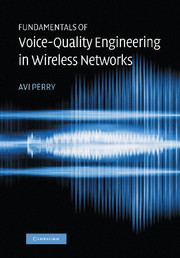Book contents
- Frontmatter
- Contents
- Preface
- List of abbreviations
- Introduction
- Part I Voice-quality foundations
- Part II Applications
- Part III Wireless architectures
- Part IV A network operator's guide for selecting, appraising, and testing a VQS
- Part V Managing the network
- Part VI Afterthoughts and some fresh ideas
- 13 Tracer probe
- 14 My sound
- 15 A procedure for evaluating and contrasting new wireless codecs' performance with and without VQS
- 16 The theory of sleep
- Part VII Recordings
- Glossary of common voice-quality systems terminology
- Brief summary of echo cancelation and VQS major standards
- Brief summary of key voice-quality assessment standards
- Bibliography
- Index
- Frontmatter
- Contents
- Preface
- List of abbreviations
- Introduction
- Part I Voice-quality foundations
- Part II Applications
- Part III Wireless architectures
- Part IV A network operator's guide for selecting, appraising, and testing a VQS
- Part V Managing the network
- Part VI Afterthoughts and some fresh ideas
- 13 Tracer probe
- 14 My sound
- 15 A procedure for evaluating and contrasting new wireless codecs' performance with and without VQS
- 16 The theory of sleep
- Part VII Recordings
- Glossary of common voice-quality systems terminology
- Brief summary of echo cancelation and VQS major standards
- Brief summary of key voice-quality assessment standards
- Bibliography
- Index
Summary
Introduction
For the entire telecommunications industry, one of the most difficult maintenance and troubleshooting tasks is pinpointing a single channel or trunk degradation in voice quality. Troubleshooting T1 or E1 problems are somewhat easier because only 24 or 32 channels are involved, degradation of the T1 or E1 facility will almost always result in an alarm indication and, using a T1 or E1 test-set, the trouble can be detected by error per second and bit error-rate testing.
However, finding a single noisy or high-loss 64 kbps trunk or voice channel can become a very long-winded task. With many carriers going to higher primary facility rates, STS-1, STM-1, OC-3 and even packet or voice-over-IP (VOIP), the problem of uncovering a single 64 kbps voice-channel degradation is an overwhelming task in most cases. The technique of switch-tracing a call involves entering the calling and called phone numbers to a number of switches, sometimes of different telecom administrations, in order to determine which voice channel from within a particular STM-1, OC-3 or an STM-1 is degraded.
The concept presented here, “tracer probe,” combines common-product implementations with a unique testing sequence to produce an easy way of determining the trunk or voice channel experiencing the problem, either in real time during a degraded test call, or after a degraded test call has ended, using a logging feature.
- Type
- Chapter
- Information
- Fundamentals of Voice-Quality Engineering in Wireless Networks , pp. 289 - 293Publisher: Cambridge University PressPrint publication year: 2006



